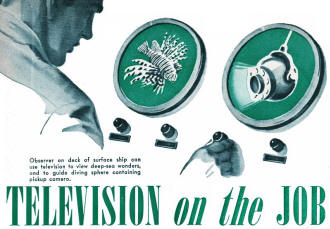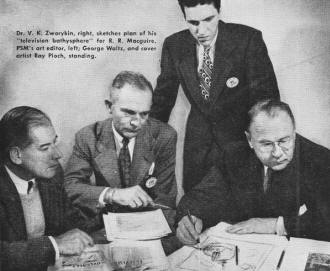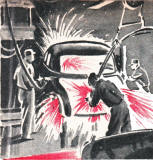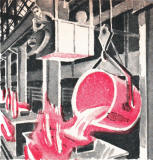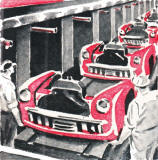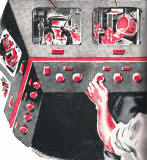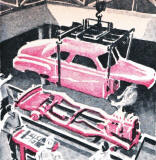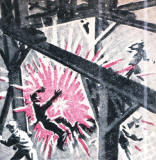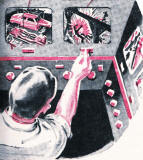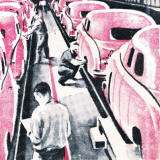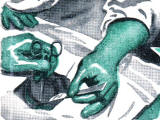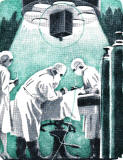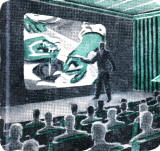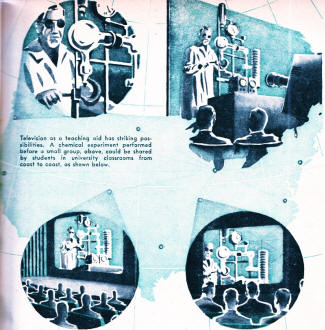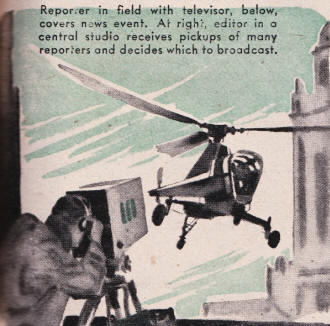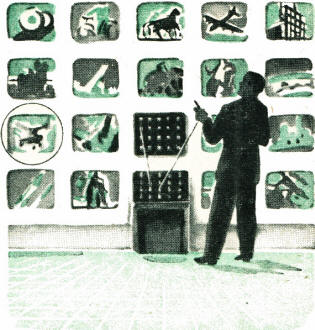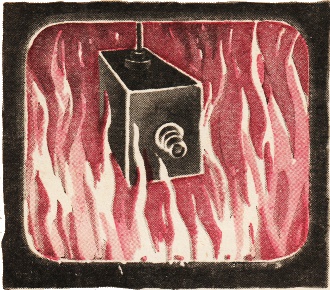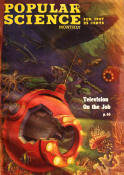Television on the Job
|
|||||||||||
Those of us growing up in the middle part of the last century remember reading predictions - even promises - of fantastic products and systems that would become reality by the end of the century (i.e., by midnight, December 31, 1999). Popular Mechanics, Popular Science, Mechanix Illustrated, Science & Mechanics, all of which I enthusiastically read, are prime examples. Examples include a flying car in every garage, domestic robots performing tasks currently done by housewives, a cancer cure in a pill, learning by electromagnetic programming of your brain, another pill to control your weight, New York to Tokyo flights in two hours, cross-continental underground bullet trains hitting 600 mph, underwater cities, lunar colonies --- you get the picture. Some of the ideas did manage to materialize, like this "Television on the Job" article in a 1947 issue of Popular Science. It proposes many scenarios whereby what is now called closed-circuit television (CCTV) is used in manufacturing processes, education, security, and experimentation in hazardous environments. Interestingly, Dr. K. Zworykin, "the father of television," is pictured in a meeting sketching a plan for his "television bathysphere" which dispatches a CCTV to extreme ocean depths rather than risking humans. Television on the JobObserver on deck of surface ship can use television to view deep-sea wonders, and to guide diving sphere containing pickup camera. By George H. Waltz, Jr. It extends human vision beneath seas, into furnaces and throughout factories Television is adding overalls to its dress clothes. Its sleeves are rolled - it is ready to go to work! To most of us, television has been a promise of armchair entertainment - a chance to have choice seats at boxing bouts, football games, news events and stage plays without budging from the budget or the living room. That phase of television is here, but television's future goes far beyond the mere prospects of animated quiz shows and soap operas you can see. Television, like radio, is a versatile tool. A relatively small percentage of the radio waves that flash around the earth today carry music and comedy to our loudspeakers. Most of them have more important missions. Radio helps us go places and do business. Without it, large-scale scheduled air travel would be impossible, sea travel would be slowed, crime prevention hampered, news coverage cut down, and international business and diplomacy limited. Television likewise means much more to us than an amusing accompaniment for radio's sound. Its workaday uses are even more dramatic than its role as an entertainer. I found that out when I got a firsthand look into television's future at the large modern laboratories of the Radio Corporation of America at Princeton, N. J. There I put questions to Dr. Vladimir K. Zworykin, director of the laboratories' program of electronic research - one of the men who helped raise television from its flickering beginnings to its present status. Getting Dr. Zworykin to talk about television was not a hard assignment. He thinks it, dreams it, lives it, and talks about it with parental love. Dr. K. Zworykin, right, sketches plan of his "television bathysphere" for R. R. Macguire, PSM's art editor, left; George Waltz, and cover artist Ray Pioch, standing.
Reproduced upon auditorium screens, the television pictures of the operation would give every member of the audience a view as clear and detailed as that of the surgeon himself. Television as a teaching aid has striking possibilities. A chemical experiment performed before a small group, above, could be shared by students in university classrooms from coast to coast, as shown below. Reporter in field with televisor covers news event. Editor in a central studio receives pickups of many reporters and decides which to broadcast. "Television," he explained, after he had shown me his laboratory, "is an extension of our sight. It gives us a simple means of getting eyewitness views of things happening in places too small, too distant, or far too dangerous for the average person to observe. Properly applied, television can show us many things that we have never seen before. It can open up whole new frontiers of research and knowledge. "Undersea exploration is an excellent example. Few divers can descend more than 200 feet. Television, however, can put our eyes there without risk to our bodies. By installing a television camera in a thick-walled metal bathysphere, lowered from a survey ship, the deepest ocean floor can be explored safely and for hours at a time by skilled observers seated comfortably in front of a direct-wire television viewer on deck - or on dry land, for that matter, if the television signals from the camera are radio-relayed from ship to shore." As Dr. Zworykin enlarged on his idea I realized that the construction of such a television bathysphere would present no great problems. It could be similar in design to the diving ball that Dr. William Beebe used in his undersea observations. With thicker walls to withstand greater pressures, it would otherwise be simpler, since a television camera, unlike a man, requires no oxygen and would be unaffected by the near-zero temperatures 600 feet under. Since scenes have been televised from the dim light of a candle, illumination would not be difficult. The modern television camera using the new Image Orthicon tube, another Zworykin-guided development, is as sensitive to light as the human eye, so floodlights for underwater television exploration would have to be no brighter than those required for human observation. The bathysphere could be lowered by cable, while remotely controlled motors built into a supporting gimbal could turn and tilt its "eye" to scan the surroundings. The bathysphere could be used to aid underwater salvage, guide the placing of for undersea oil wells, assist in rescues, and, perhaps, even test the myth of lost Atlantis. The depths that could be plumbed would be limited only by the strength of the sphere's metal shell. Similarly, according to Dr. Zworyki television cameras can give us close-up views of what goes on within chemical reviews of what goes on within chemical reaction chambers, inside fiery furnaces and behind the thick lead walls that surround atomic-fission experiments. It provides us with a third eye that is unaffected by lethal fumes, heat or radiations. What actually goes on inside smelting furnaces and glass furnaces is still pretty much anybody's guess. The heat is so great that temperatures must be measured from a distance with optical pyrometers, and quick glimpses through jet-black goggles are the only observations possible. Any closer view would sear the flesh, blind the eyes. Television cameras at strategic spots inside the furnaces could flash pictures of the mass to a viewer in the office of the plant engineer. He could watch the process from beginning to end with no more bother than switching his viewer from one camera to another. He could literally "walk around" inside the furnace. The glow from the molten metal or glass would provide more than enough illumination, and liquid cooled jackets would protect the cameras. Dr. Zworykin also envisions television as a super-supervisor in the large factory of tomorrow. Television cameras set up in the various departments of a manufacturing plant would allow one man in a central viewing room to watch, control and safeguard the entire plant's activities. Rows of vision viewers would show him exactly what was happening at nerve centers of the factory. His master control room would be an industrial equivalent of the CIC (Combat Intelligence Center) rooms that co-ordinated our fighting forces along the different fronts during the war. Such a system would speed production and safeguard life and property. A similar setup on a smaller scale could be used to control the flow of automobile assembly lines. At present, it requires the services of a corps of men to supervise the 25 miles or more of subassembly and main assembly lines that snake their way through most big automobile plants. Television cameras set up at the feeder lines and along the length of the main assembly line and wired to viewers in the main supervisor's office could bring the entire problem under his eyes. Television may well change our whole concept of educational techniques, Dr. Zworykin believes. This is particularly true in medicine, where a student's view of an operation consists of what he can see from his seat high in the operating-room amphitheater. Television, however, can give him a surgeon's-eye view of the whole proceedings. A television camera mounted in the cluster of lights over the operating table and wired to screens in classrooms would not only give each student a close-up of even the most delicate operation but would allow hundreds of students, instead of a few, to watch the demonstration. If put on the air, an operation could be witnessed by students in medical schools all over the country wherever television was available. Long-distance diagnosis is another medical possibility. With the aid of television, a doctor and his patient could take full advantage of the knowledge and skill of a specialist a thousand miles away. Public health doctors could make actual television visits to health clinics in outlying districts. Special health lectures could be delivered simultaneously to widely scattered groups. There is no reason why students some day will not get first-hand televised looks at the moon and stars through the giant Palomar telescope, watch important experiments in progress at the world's great research centers, sit in on the actual proceedings at international conferences, or "attend" any of the firsts in science, exploration and the arts. Famous lecturers and educators could be seen and heard simultaneously in schools all over the country. Television as a teaching aid was dramatically demonstrated in New York City during the war when first aid and fire-bomb-fighting methods were explained to the city's volunteer air-raid wardens via the television camera. Viewers set up at air-raid posts throughout the city made it possible for a single group of civilian-defense experts to demonstrate air-raid procedures to more wardens than ever could have been jammed into the city's largest auditorium. And what is more to the point, every warden had a close-up of the demonstration. I asked Dr. Zworykin if he thought it would be possible to equip news reporters with lightweight television cameras that would allow them to broadcast on-the-spot views of accidents, fires, train wrecks and similar news events. As an answer he showed me the compact, lightweight television camera that has been developed for use in a guided rocket. Weighing only 34 pounds, and no larger than a suitcase, it may well be the forerunner of the newscaster's "walkie lookie." It would have to be changed only slightly. Its compact transmitter and power supply, stowed in the reporter's car, would transmit the scene being televised to a main broadcasting station. There a picture editor, seated before a bank of viewers showing the individual pick-ups from perhaps a dozen reporters on their beats, could select the events he desired and rebroadcast them to the station's television public. Several department stores are experimenting with direct-wire television as a means of displaying merchandise to customers. Fashion shows, displays and special skits to demonstrate kitchen and garden equipment are televised and piped to viewers placed in the store's windows and at eye-catching spots around the store. In a sales test run by one large Eastern department store a poll of the customers showed that nine out of 10 felt television was an aid to their shopping. Television billboards are the latest advertising wrinkle. The plan, conceived by a Boston, Mass., outdoor advertising firm, calls for a network of large outdoor screens to display television sales programs broadcast by a central station. Set up on roof tops and on the sides of buildings, the television billboards will offer a variety of entertainment interspersed with commercials. A New York bank is considering installing a direct-wire television system to speed up and simplify the identification of customers. A viewer at each teller's counter connected to a camera at the identification-card files will allow him to verify signatures and bank balances without leaving his window. A similar network for the nation's police forces would speed identification of criminals by photos and fingerprints. New developments still in the laboratory - such things as three-dimensional and full-color pictures - will extend television uses even further, Dr. Zworykin believes. Full-color television alone, for example, will greatly simplify the accurate matching of colors in the paint, dye and textile industries.
Television cameras with cooling jackets can disclose what happens in smelters, glass furnaces and other places where terrific heat precludes a direct view. Cover. Undersea exploration with a pair of television bathyspheres. Painting by Ray Pioch. In the meantime, television as we know it today can go far to help industry solve its problems. Color and Monochrome (B&W) Television Articles
Posted November 9, 2023 |
|||||||||||

